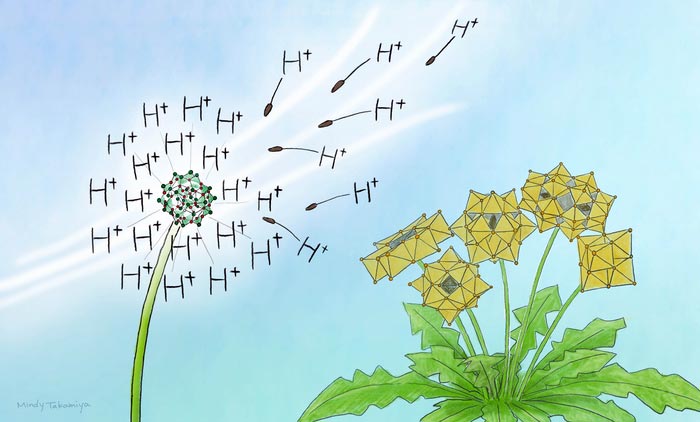Scientists serendipitously discover rare cluster compound

The metal oxide clusters obtained in this study are positively (+) charged unlike conventional negatively (-) charged ones. Its surface protons are highly acidic, which is important in catalysis.
Credit: Mindy Takamiya/Kyoto University iCeMS
The molecule is unusual and has ‘great potential’ in catalysis, conduction and other applications.
Scientists at Kyoto University’s Institute for Cell-Material Sciences have discovered a novel cluster compound that could prove useful as a catalyst. Compounds, called polyoxometalates, contain a large metal-oxide cluster carry a negative charge. They are found everywhere, from anti-viral medicines to rechargeable batteries and flash memory devices.
The new cluster compound is a hydroxy-iodide (HSbOI) and is unusual, as it has large, positively charged clusters. Only a handful of such positively charged cluster compounds have been found and studied.
“In science, the discovery of new material or molecule can create a new science,” says Kyoto University chemist Hiroshi Kageyama. “I believe that these new positively charged clusters have great potential.”
The first metal oxide cluster was discovered in 1826. Chemists have since synthesised hundreds of compounds with negatively charged clusters, which have properties useful in magnetism, catalysis, ionic conduction, biological applications and quantum information. Their properties make them useful in diverse fields from catalysis to medicine and chemical synthesis.
In more recent years, scientists have focused their attention on synthesising compounds with positively charged clusters and learning their properties.
Kageyama and his colleague Ryu Abe found their positive cluster by accident. Since 2016, the two scientists – Kageyama, a solid-state chemist and Abe, a catalytic chemist – have been on a quest to develop new compounds that can absorb visible light for photocatalysis. They were studying a chlorine-containing (Sb4O5Cl2) compound and trying to replace the chlorine atom with iodine.
“However, a new material that was completely different from what we expected was obtained accidentally,” says Kageyama.
What the scientists expected was a material that contains 22 atoms in the unit cell. What they got instead was a compound that contains 800 atoms in its unit cell.
At the beginning, the scientists could not unravel the chemical’s structure. A traditional technique called powder X-ray diffraction failed when faced with the material’s complexity. After a year, Kageyama thought he could use three-dimensional electron tomography, a cutting-edge electron microscopy technique that has attracted recent attention as a tool to image the structure of proteins. The scientists approached Artem Abakumov and Joke Hadermann at University of Antwerp, Belgium, to work on the structure. And when their collaborators sent the data back, the scientists were thrilled to see large clusters.
Further lab work showed the hydroxyiodide molecule contained acidic protons, which is important in catalysis.
“This finding may open up new possibilities in the design of solid-state catalysts,” says Kageyama.
Their work will be published in Science Advances.
DOI: https://doi.org/10.1126/sciadv.abm5379
About Kyoto University’s Institute for Integrated Cell-Material Sciences (iCeMS):
At iCeMS, our mission is to explore the secrets of life by creating compounds to control cells, and further down the road to create life-inspired materials.
For more information, contact:
Christopher Monahan / I. Mindy Takamiya
cd@mail2.adm.kyoto-u.ac.jp
Journal: Science Advances
DOI: 10.1126/sciadv.abm5379
Article Title: Polyoxocationic antimony oxide cluster with acidic protons
Article Publication Date: 17-Jun-2022
Media Contact
Izumi Mindy Takamiya
Kyoto University
mindytakamiya@gmail.com
Office: 75-753-9764
Original Source
All latest news from the category: Life Sciences and Chemistry
Articles and reports from the Life Sciences and chemistry area deal with applied and basic research into modern biology, chemistry and human medicine.
Valuable information can be found on a range of life sciences fields including bacteriology, biochemistry, bionics, bioinformatics, biophysics, biotechnology, genetics, geobotany, human biology, marine biology, microbiology, molecular biology, cellular biology, zoology, bioinorganic chemistry, microchemistry and environmental chemistry.
Newest articles

Innovative 3D printed scaffolds offer new hope for bone healing
Researchers at the Institute for Bioengineering of Catalonia have developed novel 3D printed PLA-CaP scaffolds that promote blood vessel formation, ensuring better healing and regeneration of bone tissue. Bone is…

The surprising role of gut infection in Alzheimer’s disease
ASU- and Banner Alzheimer’s Institute-led study implicates link between a common virus and the disease, which travels from the gut to the brain and may be a target for antiviral…

Molecular gardening: New enzymes discovered for protein modification pruning
How deubiquitinases USP53 and USP54 cleave long polyubiquitin chains and how the former is linked to liver disease in children. Deubiquitinases (DUBs) are enzymes used by cells to trim protein…



